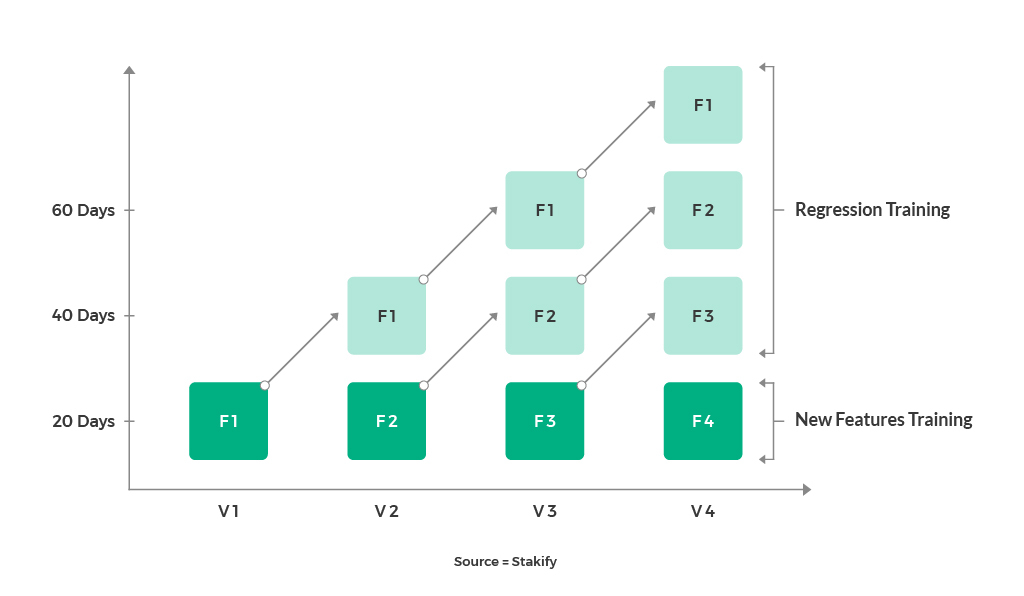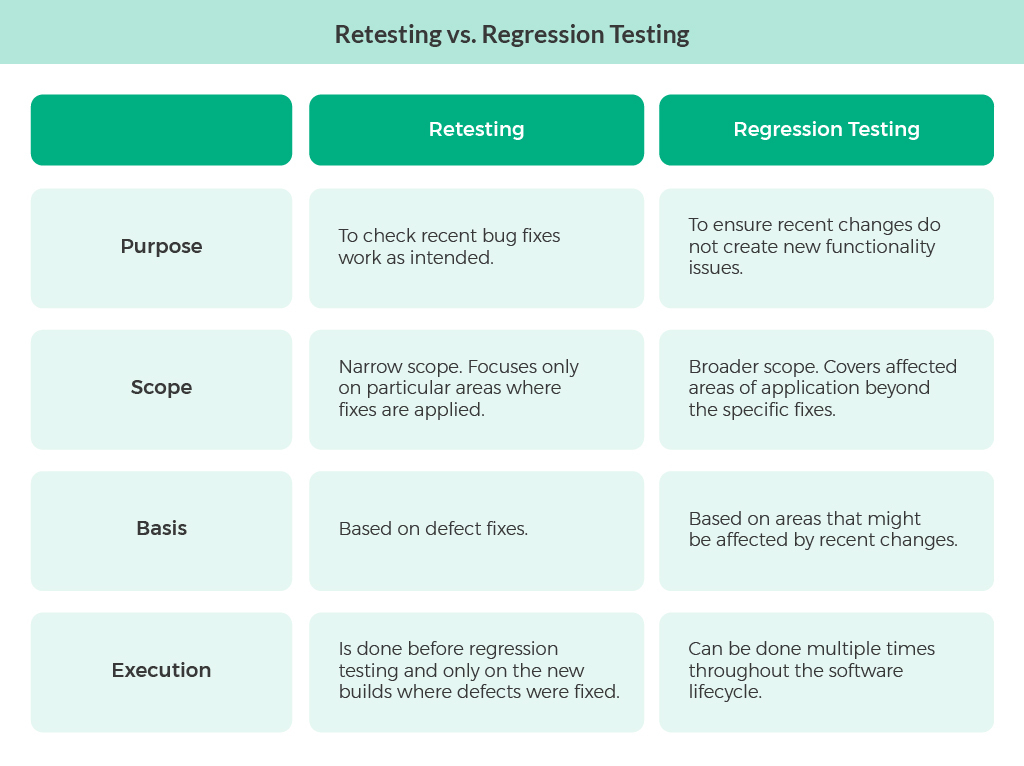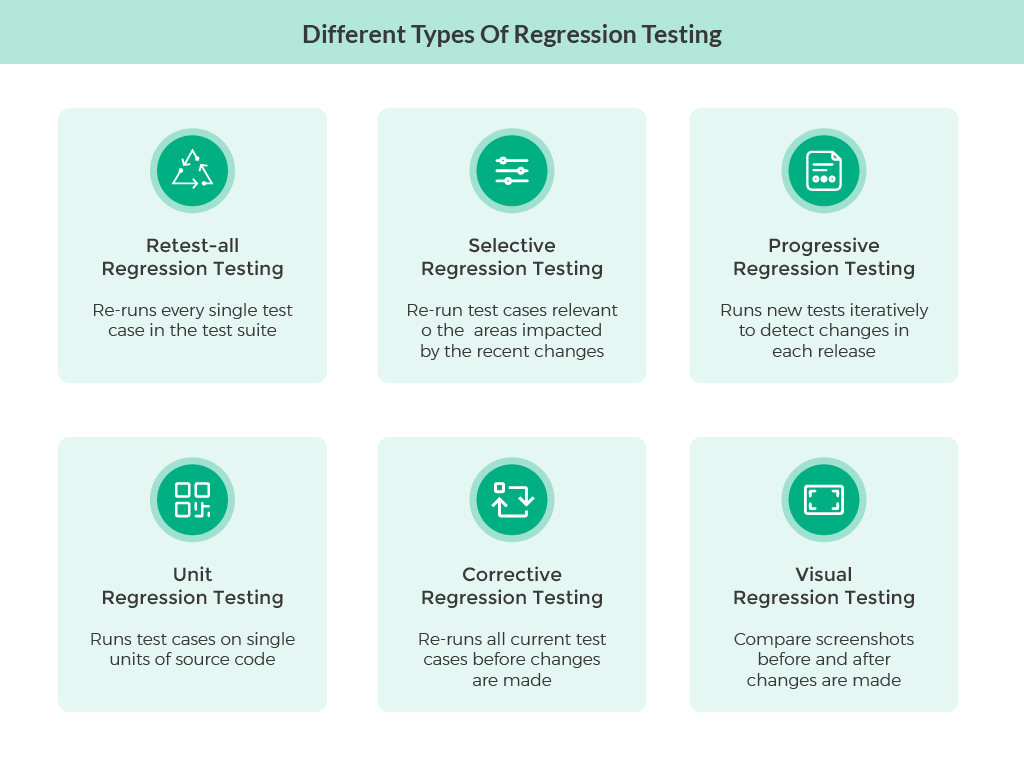Making changes to a large, well-established codebase can have unintended consequences. A seemingly simple bug fix or new feature update could disrupt existing functionalities of your software or application. This is where regression testing steps in as your safety net.
By thoroughly testing after any changes, regression testing helps prevent major disruptions that might have happened during product updates, bug fixes, and new feature launches.
This blog post will discuss everything you need to know about regression testing, its benefits, and its role in agile software development. We will also explore various types of regression testing and their applications. Keep reading!
What is Regression Testing?
Regression testing is the process of rerunning the functional and non-functional tests after every change. This ensures that the new code, feature enhancement, or product change does not adversely impact the software’s existing functionality.
Typically, a slight code change can introduce new logic, which can resurface old bugs or introduce new bugs into the system. To tackle this issue, the Quality Assurance team performs a set of regression tests every time code changes are done, as shown in the image below.

Regression testing is often performed in the following scenarios:
- When an existing feature receives a new update
- When a new feature is added to the product
- When code is fixed to remove bugs
- When code is optimized to enhance performance
- When alterations are made to the configuration
- When patch updates are launched to the software code
An Example of Regression Testing
Remember when WhatsApp introduced the video calling feature? Before deploying this update, their QA team must have conducted regression testing to ensure that existing functionalities remain intact and unaffected by new changes.
Here are a few regression tests they might have run:
- They would have run a regression test to check the messaging functionality and ensure messages were delivered promptly and accurately.
- They would have checked that users can still create, manage, and interact with contacts and groups seamlessly. They must have tested features like adding new contacts, creating group chats, and sending messages to multiple recipients with one click.
- They would have verified that users can still share various media types and ensure that media files are uploaded and downloaded correctly.
- They must have confirmed that users receive notifications for new messages promptly and can customize notification settings as before.
- Finally, they would have thoroughly tested the new video calling feature, ensuring that users can initiate and receive calls and maintain clear audio/ video quality during conversations.
What are the benefits of Regression Testing?
Now that you know what regression testing is, let us take a look at its benefits:
- Software stability: Regression testing ensures that new code changes do not adversely affect the software, web applications, or app’s existing functionalities.
- Early defect detection: With the help of regression testing, bugs can be detected early in the development process, saving time and reducing the cost of software development.
- Enhanced software quality: Regression testing enhances the overall quality of software by continuously verifying the correctness of existing functionalities. It helps maintain a high level of reliability, usability, and performance, improving the user experience.
- Reduced risk of software failures: Since each bug is detected and fixed promptly, the risk of software crashing is low.
- Increased user satisfaction: Thorough regression testing improves the overall functionality and working of the app and software, thereby increasing user satisfaction.
What makes Regression testing different from Retesting?
Regression testing is not retesting.
Both regression testing and retesting are important concepts of software testing and are often misunderstood as one. However, they serve different purposes.
Retesting, also known as confirmation testing, is performed to test specific issues that have recently been fixed. The main aim of retesting is to check that the recently fixed bugs no longer exist in the application or software, thereby confirming that the specific issue has been resolved.
Regression testing, on the other hand, is performed after retesting or system testing to ensure that recent changes made in the application or software do not impact the existing functionalities. This testing type is essential when an application undergoes constant changes and enhancements to maintain system integrity over time.

Regression Testing Techniques and Types
Even though all regression tests have the same goal of uncovering bugs and issues, there are six main types of regression testing based on the testing technique.

Retest-all regression testing
Retest-all regression testing or complete regression testing involves re-running every single test case in the test suite, regardless of whether it is directly related to the recent changes. This approach offers the most thorough coverage but can be very time-consuming, especially for large test suites. It is preferred when there is a critical update or when the codebase is small.
Selective regression testing
Also known as partial regression testing, this type of testing involves testing only test cases relevant to the areas of the software impacted by the recent changes. This helps you focus testing efforts on the specific functionalities or modules affected by the modifications, thereby reducing time and resources compared to retesting the entire system. It is the preferred choice when you have well-defined code changes.
Progressive regression testing
This approach involves gradually adding and executing new test cases to the regression test suite as the software evolves. Instead of running all test cases simultaneously, new tests are added iteratively to cover new functionalities or changes introduced in each release. It ensures the regression test suite stays up-to-date and relevant to the evolving software, maintaining adequate test coverage while minimizing testing overhead.
Progressive regression testing is suitable where the software undergoes continuous development and new features are released frequently.
Unit regression testing
Unit regression testing runs test cases on individual units of source code to determine whether they are good enough to use. A unit can be a single line of code, class, method, procedure, module, or object. In this approach, testers have a list of items to test every time changes are made in the codebase.
While unit testing offers the benefit of early bug detection during development, it can be time-consuming to implement and maintain.
Corrective regression testing
Corrective regression testing involves re-running all the current test cases even before changes in the code have been made. With this approach, testers ensure that the current codebase is working fine or not and whether the existing test cases can be used again.
Visual regression testing
Visual regression testing allows testers to compare screenshots of the site before and after changes are made in the front-end code during code deployment. It identifies visual errors such as font, layout, or object misalignment.
Regression testing tools
Regression testing tools are crucial to developers and testers throughout the Software Development Life Cycle (SDLC) as they help ensure the reliability, functionality, and performance of the code. There are two types of regression testing tools: open-source and paid tools.
Open-source regression testing tools
Open-source regression testing tools are maintained by communities of developers and testers. These software tools are developed and distributed under an open-source license, allowing users to access, modify, and distribute the source code freely. Some popular open-source regression testing tools include Selenium, Cypress, Playwright, and Appium.
Paid Regression Testing Tools
Paid regression testing tools are available under a commercial license or subscription model. These tools offer advanced features and technical support and often have dedicated teams behind them for development and maintenance. They are typically used by organizations and enterprises that require solid regression testing capabilities. Some of these tools include Micro Focus UFT One, SmartBear TestComplete, and Tricentis Tosca.
How do you define and prioritize test cases for regression testing?
Building a test-case scenario provides a structured approach to testing, ensuring comprehensive coverage across various features and functionalities. Identifying the best test case to run can help you focus on critical functionality and avoid re-executing the same tests repeatedly.
As per priority, you can:
- Select test cases having frequent defects
- Select test cases having critical functionalities
- Choose test cases with frequent code changes
- Select a risk-based testing approach
- Select test cases based on customer requirements, complexity, etc
- Choose test cases based on execution history
- Select test cases based on cost factor
Here is an example: suppose a software team has integrated multiple payment methods on an e-commerce website’s checkout page. The QA testers now have to test this new feature along with the older ones to make sure the checkout process is working correctly.
In this case, here is how we can define the test cases based on priority:
| Priority 1: Critical Functionality | Priority 2: High-Impact Features | Priority 3: Moderate Impact Features | Priority 4: Low-Impact Features |
| Test Scenario: Payment Processing | Test Scenario: User Authentication | Test Scenario: Search Functionality | Test Scenario: Help Section Navigation |
|
|
|
|
Running an E-commerce website? Here is a regression testing checklist you can use.
How to perform regression testing?

Identifying changed functions
Regression testing will begin by identifying recent changes to the software application, such as bug fixes, enhancements, or new features. The specific functions or modules of the application that have been modified as part of the recent changes will be identified, and these changes will be documented.
Identifying areas affected by changes
The next step is to trace the impact of modified functions or modules on other parts of the application and determine which areas will likely be affected by the changes. Dependencies between different functions or modules should also be considered.
Selecting suitable test cases
Then, review the existing test suite for the application, including unit tests, integration tests, and end-to-end tests. Match the identified changes to the corresponding test cases in the test suite. Determine which test cases cover the affected areas and execute them as part of regression testing.
Also, prioritize test cases based on the criticality of the affected areas, the changes’ potential impact, and any associated risks.
Running selected test cases
Selected test cases can then be executed manually or automated, depending on the nature of the tests and available resources. This helps streamline the regression testing process and ensures consistent and repeatable test execution. Also, execute the selected test cases, focusing on the areas of the application that have been modified or are likely to be affected by the changes.
Analyzing test results
Finally, the execution of test cases will be monitored, and any failures or bugs detected during regression testing will be recorded. Investigate the root cause of any failures or regression defects detected. Determine whether the issues are related to recent changes or pre-existing defects. After fixes have been implemented, re-run the affected test cases to verify that the problems have been resolved successfully.
Why is regression testing crucial in agile environments?
In agile environments, where iterative development and frequent changes are constant, regression testing is crucial for ensuring that existing functionalities remain intact despite ongoing updates. It protects against unintended consequences of new developments by verifying that changes do not break previously working features.
By conducting regression testing regularly, agile development teams can maintain the software’s overall quality, ensure the system’s stability, and facilitate the continuous delivery of new features to users.
Challenges in regression testing
While regression testing is highly beneficial, there are specific challenges associated with it:
- Time and Cost: Manual regression testing is time-consuming and costly. If tests aren’t automated and optimized, they can impact agile, iterative cycles.
- Complex: Performing regression testing on mature software products with highly complex code can be difficult.
- Bloated test suit: Maintaining the test suite and keeping regression testing focused on critical functionalities can be difficult.
- Inadequate communication and reporting: Without the right platform, ensuring clear communication between development and testing teams can be tricky. For regression testing to be effective, developers need to be in touch with the testing team and should inform testers of changes that might impact existing functionality. Likewise, testers should be able to communicate in real-time with developers about the test results.
Regression testing best practices
Here are the regression testing best practices you must follow:
- Opt for minor, frequent releases: The need for regression testing arises due to the changes made in the existing code. The more changes there are, the higher the chances of regression impacts. To prevent this, you should ask your development team to plan for code changes in the testing environment.
- Understand the software code: The QA team needs to have a complete understanding of the functioning of the software application. This helps them identify the areas that are more prone to issues occurring due to the recent changes made,
- Include QA team in code reviews: Involving the QA team in the code reviews can help them identify the modules that require continuous updates. This, in turn, will facilitate the detection of regression issues in the future.
- Ensure Dev and QA collaboration: Not just in code review, the QA team can also collaborate with developers during the software development phase to strategize regression suite planning. This collaborative approach ensures maximum test coverage alignment with release objectives.
- Document issues with defect tracking systems: In agile environments, continuous documentation of testing issues is essential for regression test planning. Thoroughly document testing problems, backed by evidence, to create automated test cases and enhance regression coverage.
- Identify correct regression test coverage: Identify regression test candidates by assessing high-risk areas, core features, and basic defect-prone functionalities. It is best to develop a logical set of test cases rather than performing exhaustive testing in a go.
- Automate regression testing: Continuous refinement and automation of the regression suite are essential for testing scalability. While the suite may involve numerous test cases, automation reduces manual testing burdens, ensuring consistent and thorough regression coverage.
Final Thoughts on Regression Testing
Regression testing is an aspect of software development that confirms new code changes do not clash with existing ones. While regression testing may require additional resources, its benefits can save software companies a lot of time and money.
With the right test management software, you can ensure your testing process runs smoothly. With QA Touch, you can group regression test cases by tagging and later filter these test cases to execute during the regression testing process.
Not only this, QA Touch’s test management platform lets you handle the complete testing process – from planning and execution to defect tracking and closure on a single platform, with features like
- Chat GPT-driven test case creation
- In-built bug tracking
- Requirement mapping and traceability matrix
- Audio and video recording of issues
Make the most out of software testing with QA Touch. Sign up today. It’s free until you are ready to upgrade.










